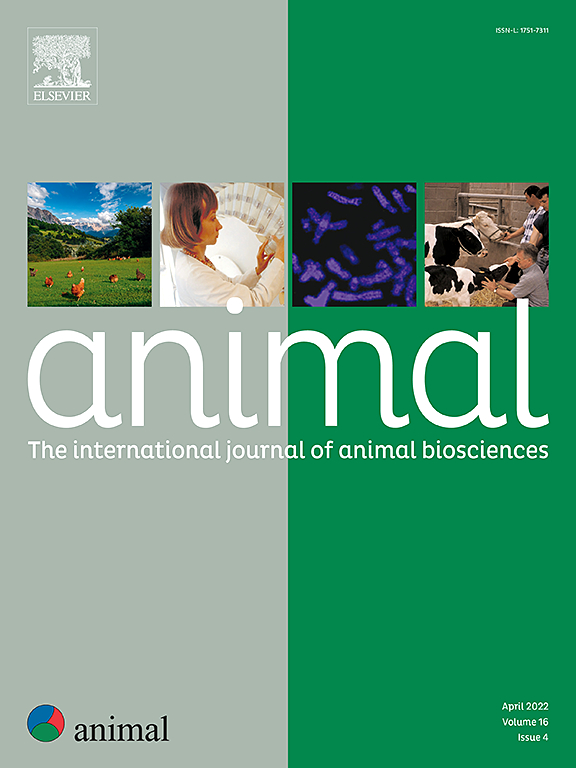Temporal changes in plasma and milk lipids in response to an esophageal bolus of rumen-protected fish oil in lactating Holstein dairy cows
IF 4
2区 农林科学
Q1 AGRICULTURE, DAIRY & ANIMAL SCIENCE
引用次数: 0
Abstract
Feeding very-long-chain omega-3 (VLC n-3) fatty acids (FA), which are found in fish oil, may have beneficial effects on health, fertility, and milk production in the dairy cow. Rumen-protected technologies aim to prevent the ruminal biohydrogenation of VLC n-3 FA. To test the effects of these technologies on circulating FA and phospholipid concentrations, and milk FA concentrations, six mid-lactation, multiparous, pregnant Holstein dairy cows (mean ± SD: 155 ± 19 days in milk; 3.0 ± 0.5 body condition score; 3.2 ± 1.1 lactations; 644 ± 23 kg BW) were randomly assigned to treatments in a study with a replicated 3 × 3 Latin Square design. Cows were unsupplemented (control) or supplemented with a single esophageal bolus of a gelatin capsule containing a fish oil product coated in palm oil triglycerides or modified starch (TAG and STR, respectively). The provision of either fish oil product provided 10 g equivalent of VLC n-3 FA including 20:5 n-3 and 22:6 n-3. Cows were fed a total mixed ration to meet or exceed nutrient requirements and were milked thrice daily. Blood was sampled at 0, 2, 4, 6, 8, 10, 12, 16, 18, 20, 24, and 36 h, relative to bolus administration. A 7-d washout period was utilized between each bolus delivery. Extracted plasma was analyzed for individual FA and phospholipid concentrations using gas chromatography and mass spectrometry. Separated milk fat was analyzed for individual milk FA using gas–liquid chromatography and a flame-ionization detector. Data were analyzed under a mixed model with the random effect of cow, and the fixed effects of treatment, hour, and period. Plasma concentrations of 20:5 n-3 and 22:6 n-3 increased over time by TAG and STR, relative to control. Plasma concentrations of lysophophatidylcholine-20:5, −22:5 and −22:6, and phosphatidylcholine (PC)-38:5 and −38:6 were higher in TAG and STR by h 10, relative to control. Plasma PC-40:5 and −40:6 concentrations were greater in cows administered STR by h 10, relative to TAG. Total milk n-3 increased over time in treated cows compared to control. We conclude that triglyceride- or starch-encapsulated fish oil increases the plasma and milk concentrations of VLC n-3 FA and phospholipids containing these acyl chains in lactating cows.
求助全文
约1分钟内获得全文
求助全文
来源期刊

Animal
农林科学-奶制品与动物科学
CiteScore
7.50
自引率
2.80%
发文量
246
审稿时长
3 months
期刊介绍:
Editorial board
animal attracts the best research in animal biology and animal systems from across the spectrum of the agricultural, biomedical, and environmental sciences. It is the central element in an exciting collaboration between the British Society of Animal Science (BSAS), Institut National de la Recherche Agronomique (INRA) and the European Federation of Animal Science (EAAP) and represents a merging of three scientific journals: Animal Science; Animal Research; Reproduction, Nutrition, Development. animal publishes original cutting-edge research, ''hot'' topics and horizon-scanning reviews on animal-related aspects of the life sciences at the molecular, cellular, organ, whole animal and production system levels. The main subject areas include: breeding and genetics; nutrition; physiology and functional biology of systems; behaviour, health and welfare; farming systems, environmental impact and climate change; product quality, human health and well-being. Animal models and papers dealing with the integration of research between these topics and their impact on the environment and people are particularly welcome.
 求助内容:
求助内容: 应助结果提醒方式:
应助结果提醒方式:


